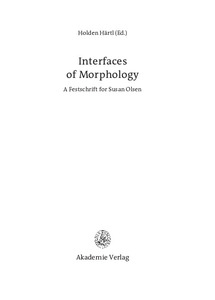Teil eines Buches

Arguments of non-heads
Zusammenfassung
The current paper investigates these cases from a lexicalist perspective. In particular, I will discuss whether realizations of arguments of non-heads of the above types are based on a regular grammatical process or not. I will argue that this is the case indeed with constructions of the type Designanalyse des Geschirrs, where the post-nominal element figures as argument of both the head as well as the non-head. In contrast, (prepositional) external argument realizations of the type in (1)—i.e. constructions in which the post-nominal element satisfies an argument slot of the non-head predicate alone—will be approached from a non-grammatical, pragmatically oriented perspective.
In the second part of the paper, I will take a closer look upon verb-noun compounds like Fahrgemeinschaft in (1)a, Sägewerk (sawmill) etc. I will claim that the argument variables of the verbal non-heads are nevertheless lexically still active after the word-formation process, that is, in some way “inherited” to the compound. At this point it is vital to note that my assumptions do not necessarily imply a syntactic feature percolation operation (as proposed by, e.g., Harley 2008). Rather, I will assume a (lexical-semantic) operation of function composition to be at work in constructions like Designanalyse des Geschirrs. Furthermore, based on insights from PRO-configurations as well as sentential complements, I will implement a lexical-structural projection below the word level, under the assumption of two separate grammatical domains, i.e., syntax and morphology, which share a common generative structure building apparatus.
In the second part of the paper, I will take a closer look upon verb-noun compounds like Fahrgemeinschaft in (1)a, Sägewerk (sawmill) etc. I will claim that the argument variables of the verbal non-heads are nevertheless lexically still active after the word-formation process, that is, in some way “inherited” to the compound. At this point it is vital to note that my assumptions do not necessarily imply a syntactic feature percolation operation (as proposed by, e.g., Harley 2008). Rather, I will assume a (lexical-semantic) operation of function composition to be at work in constructions like Designanalyse des Geschirrs. Furthermore, based on insights from PRO-configurations as well as sentential complements, I will implement a lexical-structural projection below the word level, under the assumption of two separate grammatical domains, i.e., syntax and morphology, which share a common generative structure building apparatus.
Zitierform
In: Härtl, Holden (Hrsg.): Interfaces of morphology : a Festschrift for Susan Olsen. Akademie Verlag: Berlin 2013, S. 163-177; doi:10.1524/9783050063799, eisbn:978-3-05-006379-9, isbn:978-3-05-006056-9Zitieren
@inbook{doi:10.17170/kobra-202105123888,
author={Härtl, Holden},
title={Arguments of non-heads},
pages={163-177},
publisher={Akademie Verlag},
year={2013}
}
0500 Oax
0501 Text $btxt$2rdacontent
0502 Computermedien $bc$2rdacarrier
1100 2013$n2013
1500 1/eng
2050 ##0##http://hdl.handle.net/123456789/12928
3000 Härtl, Holden
4000 Arguments of non-heads / Härtl, Holden
4030
4060 Online-Ressource
4085 ##0##=u http://nbn-resolving.de/http://hdl.handle.net/123456789/12928=x R
4204 \$dTeil eines Buches
4170
5550 {{Nominalkompositum}}
5550 {{Argumentstruktur}}
5550 {{Kompositum}}
5550 {{Verbalkompositum}}
7136 ##0##http://hdl.handle.net/123456789/12928
<resource xsi:schemaLocation="http://datacite.org/schema/kernel-2.2 http://schema.datacite.org/meta/kernel-2.2/metadata.xsd"> 2021-06-11T10:12:22Z 2021-06-11T10:12:22Z 2013 doi:10.17170/kobra-202105123888 http://hdl.handle.net/123456789/12928 eng Akademie Verlag Urheberrechtlich geschützt https://rightsstatements.org/page/InC/1.0/ 420 Arguments of non-heads Teil eines Buches The current paper investigates these cases from a lexicalist perspective. In particular, I will discuss whether realizations of arguments of non-heads of the above types are based on a regular grammatical process or not. I will argue that this is the case indeed with constructions of the type Designanalyse des Geschirrs, where the post-nominal element figures as argument of both the head as well as the non-head. In contrast, (prepositional) external argument realizations of the type in (1)—i.e. constructions in which the post-nominal element satisfies an argument slot of the non-head predicate alone—will be approached from a non-grammatical, pragmatically oriented perspective. In the second part of the paper, I will take a closer look upon verb-noun compounds like Fahrgemeinschaft in (1)a, Sägewerk (sawmill) etc. I will claim that the argument variables of the verbal non-heads are nevertheless lexically still active after the word-formation process, that is, in some way “inherited” to the compound. At this point it is vital to note that my assumptions do not necessarily imply a syntactic feature percolation operation (as proposed by, e.g., Harley 2008). Rather, I will assume a (lexical-semantic) operation of function composition to be at work in constructions like Designanalyse des Geschirrs. Furthermore, based on insights from PRO-configurations as well as sentential complements, I will implement a lexical-structural projection below the word level, under the assumption of two separate grammatical domains, i.e., syntax and morphology, which share a common generative structure building apparatus. open access Härtl, Holden Berlin doi:10.1524/9783050063799.163 Nominalkompositum Argumentstruktur Kompositum Verbalkompositum publishedVersion Interfaces of morphology : a Festschrift for Susan Olsen Härtl, Holden doi:10.1524/9783050063799 eisbn:978-3-05-006379-9 isbn:978-3-05-006056-9 163-177 Studia grammatica ;; 74 false </resource>
Die folgenden Lizenzbestimmungen sind mit dieser Ressource verbunden:
Urheberrechtlich geschützt

